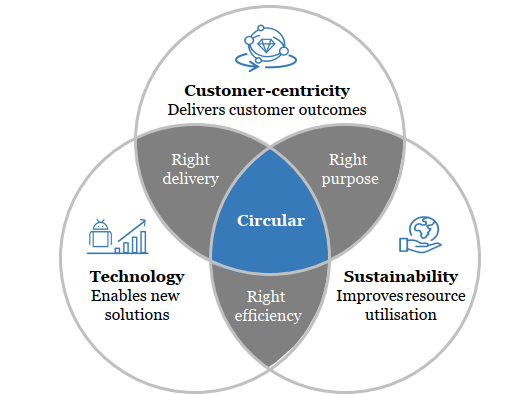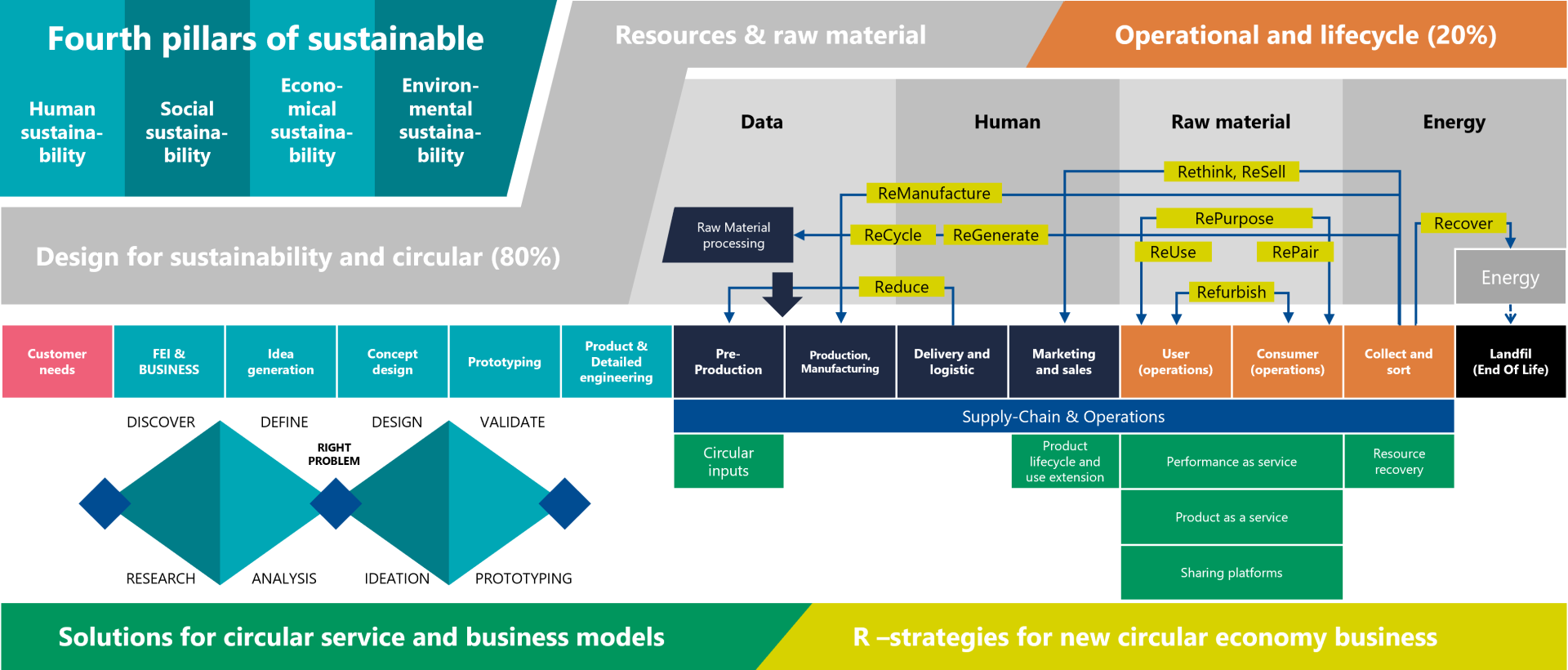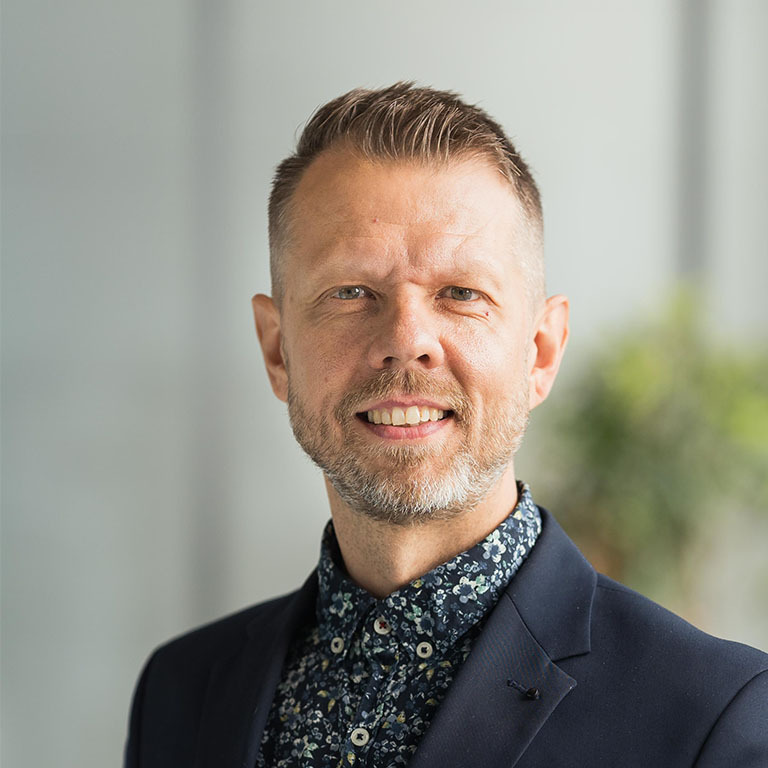03/10/2023
The circular economy is a game changer in the machinery industry – what should happen in the supply chain?
The circular economy is a key model for reforming the economy and a necessity for solving the major climate, natural resource and other sustainability goals globally. Today, the circular economy is more than just an opportunity: technological know-how has taken giant steps forward, and the willingness of customers, consumers and governments to promote circular economy solutions is more significant than ever before.
The circular economy provides the keys to the solution to combating climate change and the loss of biological diversity. It allows us to grow and share wealth while reducing greenhouse gas emissions, waste and pollution.1 By transitioning to a circular economy, companies and governments can not only reduce waste and environmental impacts but also create new economic opportunities and improve the productivity of resources. Only 7.2% of the world’s economy is part of the circular economy2, so there is plenty to do for everyone.
The three main themes of the circular economy are technology, customer-centricity and sustainability. Sustainability rests on four so-called pillars of sustainability: human and cultural sustainability, environmental sustainability, economic sustainability and social sustainability.

Circular economy keeps resources in use for as long as possible
In a circular economy, waste and pollution are minimized. This is based on the principles of reducing, reusing and recycling materials and resources, rather than the traditional linear model of resource recovery, use and disposal.
One of the circulation systems of the circular economy is a closed-loop system in which resources are used efficiently and sustainably and no waste is generated; instead, resources are always recycled again and again. Narrowing loops approach means that less energy, water and raw materials are used in the manufacturing of a product, meaning the business is resource efficient. Slowing loops refers to the extension of the product’s lifespan by means of service and maintenance.
The aim of these cycles is to create a unique approach to different starting points and goals that can help reduce the negative environmental effects of economic activity and thereby improve resource efficiency.
Product design can determine up to 80 percent of the environmental impact during the product’s entire life cycle. The role of product design, in other words, is very significant.
What does the circular economy mean in practice?
The circular economy offers a concrete approach to achieving sustainable growth. Products are designed to be long-lasting, durable and easy to repair or recycle, and materials are reused or recycled to create new products. This helps to reduce the amount of waste generated and increase the resources needed to manufacture new products. In this way, new economic opportunities are created when new business models and value chains are developed.
The circular economy can be implemented in several different ways:
- Designing products and systems that can be easily repaired, refurbished or recycled
- Developing business models that encourage the use of shared or rented resources
- Investing in infrastructure and technology that enable the recovery and reuse of materials
- Recovering as energy – this is the last option that should be considered, because then the resource is no longer available for solutions with a higher value added
The circular economy highlights interdependencies between different organizations and companies. The importance of the role of users and consumers is also emphasized.
Is the circular economy profitable?
Many actors may face impediments to growth and profitability during the transition. At the same time, however, it is also possible to create new business that is both sustainable and profitable.
In terms of overall impact, the manufacturing cycle alone can generate net material cost savings of up to USD 630 billion per year in the EU alone, according to an estimate by Goldman Sachs.4 It has also been calculated that product design can determine up to 80 percent of the environmental impact during the product’s entire life cycle
Table 1. Circular economy business models compared to the linear economy model3,6,7
|
Circular economy business models |
Circular economy strategies |
What does this mean in the circular economy? |
Linear business models |
What does this mean in a linear business model? |
|
Circular Inputs |
|
Sustainable product design: Design products according to cycles and sustainability goals. Circular supplies: Utilize side flows generated from the processes of other operators or refuse to use unsustainable solutions. Regenerate: Create operations that conform to natural cycles in the ecosystem and give more than is taken. Refuse: There is no need for the product or it can be completely replaced by another product. |
Taking resources |
Procure virgin materials and other production inputs. |
|
Sharing Platform |
|
Utilize new models of the sharing economy and think of the product as a new kind of solution that increases utilization. |
Design, manufacturing, distribution |
Products are designed for single use, and distribution solutions are mostly global supply chains. |
|
Product As a Service |
|
Product as a Service: Offer customers use of the product for a subscription fee or usage-based payments instead of ownership. Performance as a Service: Offer customers a predetermined solution as a service and commit to guaranteeing the quality level and outcome. |
Use and consumption |
The owned product is used until it breaks down or is no longer used for other reasons. |
|
Product Lifecycle Extension |
|
Reuse: The use of a product in good condition by another user for the same purpose Repair: Repair, service and maintenance that enables the continued use of the product for the same purpose Refurbish: Refurbishing an old and defective product for today’s needs Remanufacturing: Utilization of an end-of-life product or its components for the same purpose Repurpose: Utilization of an end-of-life product or its components for a different purpose Reduce: Making production or usage more efficient by reducing the use of natural resources and materials |
||
|
Resource |
|
Recycle: Processing materials to obtain the same (= high value) or lower (= low value) quality Recovery: Incineration of materials and recovery for energy use |
Landfil: Discarding as waste and energy |
The product as such or its components are discarded and will not be reused in any way. The resource is disposed of by incinerating it into energy. |
Circular economy requires a new type of technology
If industrial business wants to make full use of circular economy business models and strategies, Industry 4.0 and Industry 5.0 solutions such as artificial intelligence, IoT (Internet of Things) and automation must be utilized. These solutions enable smart and flexible management and production optimization in the operations of plants and processes. This offers an opportunity to improve the efficient utilization of manufacturing, materials and resources, as well as to reduce waste and environmental damage.
Industry 5.0, materials and resources are used as efficiently as possible according to the principles of the circular economy and sustainability, and processes can be planned by promoting resource wisdom. The purpose of technology in Industry 5.0 is to improve people’s quality of life and achieve sustainability. Industry is a significant user of raw materials and other resources. The development and implementation of new technologies is therefore essential.
Manufacturing for circular economy
An interesting perspective is provided by resource-wise manufacturing technologies, such as additive manufacturing (3D printing) and smart manufacturing with their numerous applications. New manufacturing methods and processes can be used to improve material and energy efficiency and to operate in circular economy value chains in a new way.
In smart manufacturing in a circular economy, the production processes adapt to changes in the market by utilizing smart technologies, procuring raw materials and automating production capacity. Monitoring material flows in different stages of the chain and risk management are also emphasized in terms of availability. Consequently, special attention in the circular economy must be paid to managing the logistics of value creation chains, utilizing resources more efficiently and developing production processes with the help of digitization and manufacturing technologies.
New competence needs
The challenges and requirements of design increase substantially in a circular economy, but at the same time, design becomes even more relevant. Processes must be developed to correspond to circular economy business and ecosystem models, and the demand for new skills also increases.
The new competence needs highlight knowledge of value chains and materials, as well as of serviceability and repairability considerations. Both the special properties of recycled raw materials and a product’s recyclability must be taken into account in design and technology development. Competence in these properties will also be emphasized in the production stage of the products.

Challenges of transitioning to a circular economy model
Although we see significant advantages and opportunities in the circular economy, at no point are they self-evident. Transitioning to sustainable business models requires major changes from organizations. For example, a new kind of business thinking and a redesign of planning processes and supply chains are needed.
Flexibility solutions are one significant challenge, and one of the most critical elements is creating transparency.9 Achieving this requires the integration of customers and resource suppliers into enterprise resource planning systems and sales and delivery processes. In addition, companies must have strong and long-term circular economy visions, as well as clear and concrete plans for achieving these visions. The necessary commitment must be obtained from a wide range of external stakeholders.
Another challenge is the lack of a unified ecosystem. In Finland, work on fixing this situation has begun in earnest, but a lot of work remains to be done. In addition, numerous other challenges must be solved, such as the availability of materials and the maturity levels of technology, changing production lines, and developing product return processes and recycling.
Industry is a significant user of raw materials and other resources. The development and implementation of new technologies is therefore essential.
Circular economy accelerates the development of new technologies and solutions
A circular economy promotes sustainable growth by creating a closed cycle system within which waste is minimized and resources are saved. In this way, the circular economy promotes the development of innovative solutions that promote a more sustainable future.
The goals regarding the circular economy are very demanding. Although some actors are already well along the way in this transition, everyone still has the opportunity to choose which stage of the circular economy they want to participate in and which special strategy they want to implement most strongly. The will generally exists, and digitization plays a key role here, but new types of business models and win-win models of value creation are also needed.
In the face of massive change, responsibility guides us to try and do our best. Essentially, the purpose of the circular economy is to create a world in which economic wellbeing is combined with environmental and social sustainability – and one in which current and future generations can thrive.
Examples of circular economy technologies and business models
Performance as a Service – one of the circular economy business models
A good example of Performance as a Service is provided by Rolls Royce, which is committed to producing efficiency and profit for its customers with its own technologies based on the Power By Hour model. The company takes care of maintenance and repairs so that the agreed result is achieved as promised.
Similar programs include proven ways to reduce inventory costs in the airline industry. Airlines pay for services based on aircraft utilization. The main advantage for operators is that they do not have to own a warehouse. This reduces recurring overhead costs while improving the quality of the service or operation.
https://www.mrobusinesstoday.com/power-by-the-hour/
Remanufacturing
Many mobile machinery manufacturers have started again to manufacture new components from used components and resell them. For example, Caterpillar promises to remanufacture its products at the end of their service life and restore them to their original condition. This helps reduce the cost of ownership and operation, as the customer gets new quality at a fraction of the cost of a new component.
https://www.caterpillar.com/en/company/sustainability/remanufacturing.htlm
Recycling and repurposing
Spinnova Plc
Spinnova Plc has developed a technology capable of producing textile fibers from wood, leather and other natural materials. Due to the way the pulp is processed, Spinnova can use almost any cellulose-containing biomass, grind it into microfibrils and spin it into textile fiber. Although wood is their spearhead raw material, they have also studied leather waste and agricultural waste, such as wheat straw and cotton waste.
Infinited Fiber Company
Infinited Fiber Company’s patented technology utilizes raw materials from textiles that would otherwise end up in landfills or incineration and transforms them into brand-new, high-quality fibers for the textile industry.

Mika Patrakka
MBA, Industrial Designer
Mika works as a Business Development Manager in the Machinery and Equipment business unit. He has more than 10 years of experience in various roles in design, development and management. Mika promotes sustainable growth and the development of products and services and helps companies create circular economy-based business and strategies. His development philosophy is guided by the growth mindset and customer experience, and he utilizes service design and agile methods in his work.
mika.patrakka@elomatic.com
References
- Ellen MacArthur https://ellenmacarthurfoundation.org/topics/circular-economy-introduction/overview accessed 31.3.2023
- Circularity GAP 2023 https://www.circularity-gap.world/2023
- Circular Economy Playbook for Finnish SMEs – Sitra, Teknologiateollisuus & Accenturestrategy Circular Economy Playbook | Teknologiateollisuus
- Goldman Sachs https://www.goldmansachs.com/insights/pages/gs-research/gs-sustain-circular-economy/report.pdf
- Schwarz et al 2017; European Commission 2014 https://ec.europa.eu/commission/presscorner/detail/fi/ip_22_2013
- Nancy M. P. Bocken, Ingrid de Pauw, Conny Bakker & Bram van der Grinten (2016) Product design and business model strategies for a circular economy, Journal of Industrial and Production Engineering, 33:5, 308-320, DOI: 10.1080/21681015.2016.1172124. Product design and business model strategies for a circular economy https://www.researchgate.net/publication/309699661_Product_design_and_business_model_strategies_for_a_circular_economy
- Kirchherr, J., Reike, D. & Hekkert, M. 2017. Conceptualizing the circular economy: An analysis of 114 definitions. Resources, conservation and recycling, 127, pp. 221-232. doi:10.1016/j.resconrec.2017.09.005 https://www.sciencedirect.com/science/article/pii/S0921344917302835#fig0005 9R
- Adaped from Waste to Weath, 2015, The Circular Economy Handbook, 2020 & Sustainable growth with circular economy business models, SITRA
- Bain & Company https://www.bain.com/insights/operations-priority-number-one-global-machinery-and-equipment-report-2022/
